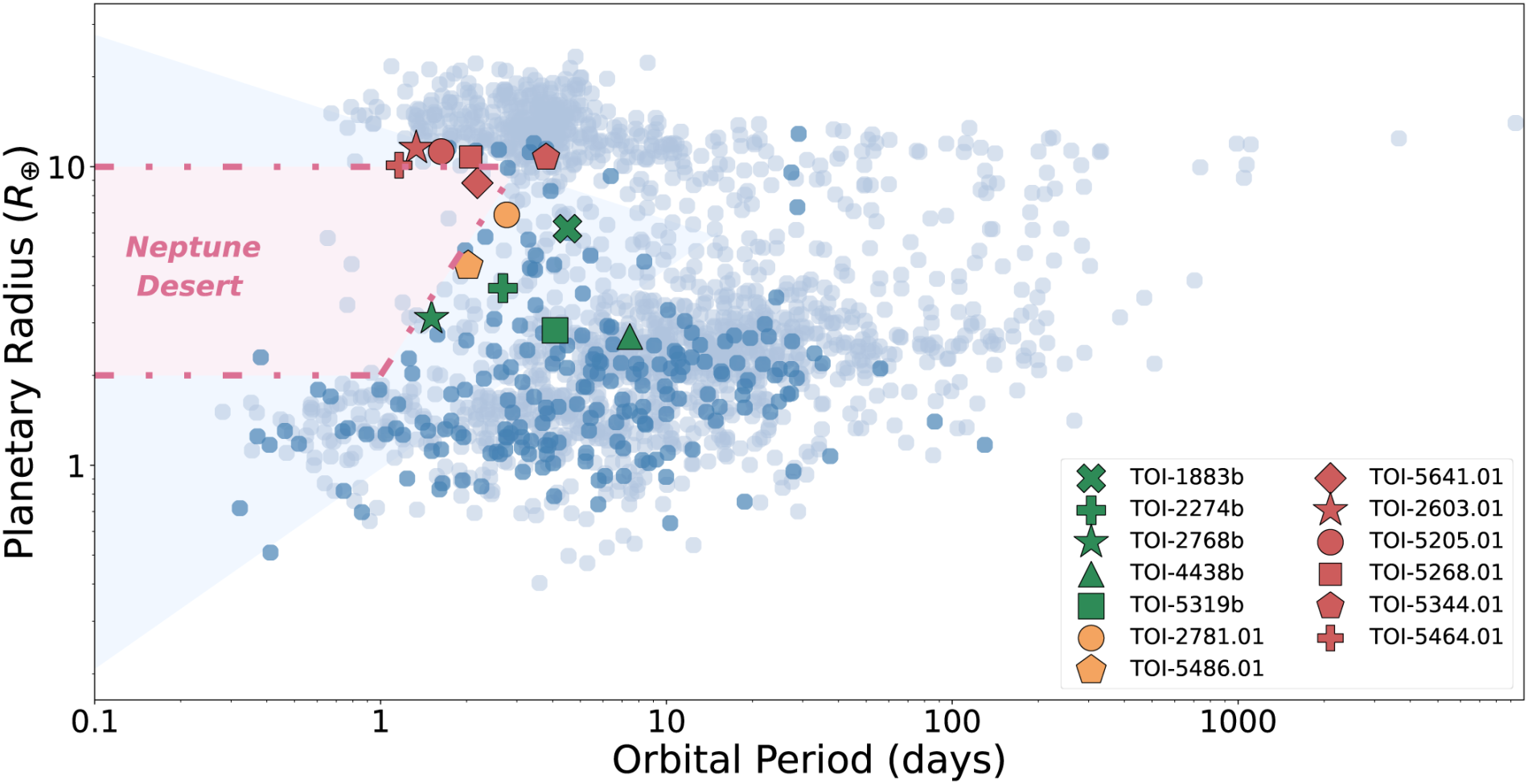Several Neptune-like planets discovered in a theoretically barren region
The study, focusing on the planetary nature of thirteen objects of interest from the TESS mission, confirms the existence of five new planets around red dwarf or M-type stars, which are smaller and cooler than our Sun.
The planets lie within or very near the "Neptunian desert," a region noted for the scarcity of planets with characteristics similar to those of Neptune.
The distribution of planets in the over five thousand distant solar systems discovered to date forms a complex puzzle. There is a region in the planetary orbit graph, known as the "Neptunian desert", where very few Neptune-like planets with orbits of between two and four days period around their star have been recorded to date. Now, a scientific team led by the IAA-CSIC and the IAC has validated, using a novel technique, new planets around red dwarf stars located precisely in this desert. The finding is published in the journal Astronomy & Astrophysics.
The research aimed to clarify the planetary nature of thirteen TESS Objects of Interest (TOIs), detected by NASA’s exoplanet search mission. “These objects could be either planets or other bodies that photometrically resemble them, such as brown dwarfs – considered the link between low-mass stars and large gas giants – or binary star systems,” explains Alberto Peláez Torres, a researcher at the Instituto de Astrofísica de Andalucía (IAA-CSIC) and the Instituto de Astrofísica de Canarias (IAC), who leads the study.
AN INNOVATIVE METHODOLOGY
When selecting the most suitable method to identify the nature of these unclassified planetary objects, the host star –around which they orbit– plays a key role. In some cases, there are planets orbiting stars whose faintness precludes studies with more traditional techniques. This is precisely the case with red dwarfs, the host stars at the focus of this research.
“M-type stars are ideal for discovering potential small planets orbiting them, due to their low temperature and small size, which reduces the contrast between the radii of the star and the planet,” explains Alberto Peláez (IAA-CSIC).
Thus, the research team opted for an innovative methodology based on multicolour transit photometry, which involves observing a star’s brightness through various colour filters. They used ground-based instruments such as MuSCAT2, MuSCAT3, and LCO-SINISTRO, alongside high spatial resolution observations and TESS light curves. As a result, they validated five of the TESS exoplanet candidates: TOI-1883b, TOI-2274b, TOI-2768b, TOI-4438b, and TOI-5319b.
This work contributes to consolidate multicolor transit photometry as a valid and efficient technique in the field of exoplanets to confirm or rule out the planetary nature of the candidates proposed by the TESS mission," emphasizes Emma Esparza, researcher at the Instituto de Astrofísica de Canarias (IAC) and second author of the paper.
This discovery holds additional significance, as several of the five validated planets, particularly TOI-2768b, are located directly within the Neptunian desert. This region is marked by a scarcity of Neptune-sized planets – four times the Earth’s radius – making the discovery especially unusual. Various studies suggest that physical phenomena in this area “drain” planets of these characteristics, such as atmospheric mass loss due to high-energy irradiation from their star, a process known as photoevaporation.

Artist's rendering of the TESS exoplanet candidate: TOI-2768 b, validated in this work. Comparison with Earth. Credits: NASA (https://science.nasa.gov/exoplanet-catalog/toi-2768-b/)
“The discovery of planets in the Neptunian desert is crucial for advancing exoplanet studies, as investigating their atmospheres could shed light on the phenomena affecting these planets and explain their scarcity in this region,” says Alberto Peláez (IAA-CSIC).
NEW EMPIRICAL DEFINITION OF ITS BOUNDARIES
Over the years, planetary discoveries have shown that the Neptune desert, a concept proposed in 2016 that included planets with orbital periods between one and four days and radii between two and six times that of Earth, does not match the current distribution of exoplanets.
With this premise, the newly published study proposes a revised definition of the Neptune desert, including only planets between two and ten times the size of Earth, which must also orbit very close to their star: if they are at the smaller end of this range, they complete an orbit in one day; if larger, it takes around three days.

The blue shaded region shows the Neptune Desert as defined by Mazeh et al. (2016). The pink shaded region corresponds to that suggested in the new definition of the region proposed in this study. In addition, the location of the validated and non-validated planet candidates is shown in the period-radius diagram. The green polygons show the location of the validated planets. Credit: A. Peláez-Torres et al. A&A, 690 (2024) A62
This study lacks a representative enough sample of validated planets –near or within the Neptunian desert– to provide conclusive statistical data. “Even so, the discovered planets open the door to future studies on their mass, density, and atmospheric characteristics, which could provide key information for understanding the physical nature of this region of space,” concludes Alberto Peláez (IAA-CSIC).
- “Validation of up to seven TESS planet candidates through multi-colour transit photometry using MuSCAT2 data” https://doi.org/10.1051/0004-6361/202347251
- Alberto Peláez – apelaez@iaa.es
- Instituto de Astrofísica de Andalucía (IAA-CSIC)
- Unidad de Divulgación y Comunicación
- Amanda López – alm@iaa.es
- Emilio García – garcia@iaa.es - 649 407 445 (vía whatssap)
- https://www.iaa.csic.es
- https://divulgacion.iaa.csic.es

